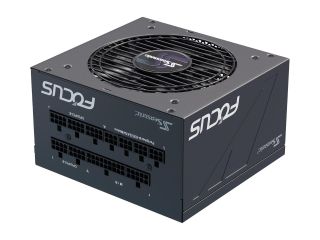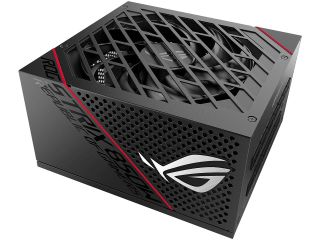Why you can trust Tom's Hardware
To learn more about our PSU tests and methodology, please check out How We Test Power Supply Units.
Primary Rails And 5VSB Load Regulation
The following charts show the main rails' voltage values recorded between a range of 40W up to the PSU's maximum specified load, along with the deviation (in percent). Tight regulation is an important consideration every time we review a power supply because it facilitates constant voltage levels despite varying loads. Tight load regulation also, among other factors, improves the system’s stability, especially under overclocked conditions and, at the same time, it applies less stress to the DC-DC converters that many system components utilize.








Load regulation is loose on all rails, not that we expect something different given the outdated platform.
Hold-Up Time
Put simply; hold-up time is the amount of time that the system can continue to run without shutting down or rebooting during a power interruption.




The hold-up time is extremely short! At least the power ok signal is accurate, but also too short.
Inrush Current
Inrush current, or switch-on surge, refers to the maximum, instantaneous input current drawn by an electrical device when it is first turned on. A large enough inrush current can cause circuit breakers and fuses to trip. It can also damage switches, relays, and bridge rectifiers. As a result, the lower the inrush current of a PSU right as it is turned on, the better.


Inrush currents are sky high!
Leakage Current
In layman's terms, leakage current is the unwanted transfer of energy from one circuit to another. In power supplies, it is the current flowing from the primary side to the ground or the chassis, which in the majority of cases is connected to the ground. For measuring leakage current, we use a GW Instek GPT-9904 electrical safety tester instrument.
The leakage current test is conducted at 110% of the DUT's rated voltage input (so for a 230-240V device, we should conduct the test with 253-264V input). The maximum acceptable limit of a leakage current is 3.5 mA and it is defined by the IEC-60950-1 regulation, ensuring that the current is low and will not harm any person coming in contact with the power supply's chassis.
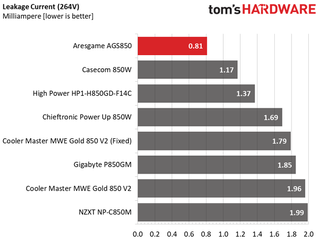
Leakage current is low, which seems to be the only good thing in this PSU, so far at least.
10-110% Load Tests
These tests reveal the PSU's load regulation and efficiency levels under high ambient temperatures. They also show how the fan speed profile behaves under increased operating temperatures.
| Test | 12V | 5V | 3.3V | 5VSB | DC/AC (Watts) | Efficiency | Fan Speed (RPM) | PSU Noise (dB[A]) | Temps (In/Out) | PF/AC Volts |
| 10% | 5.164A | 1.956A | 1.942A | 0.999A | 85.005 | 80.817% | 796 | 27.8 | 35.52°C | 0.981 |
| 12.278V | 5.114V | 3.399V | 5.004V | 105.183 | Row 2 - Cell 6 | Row 2 - Cell 7 | Row 2 - Cell 8 | 39.28°C | 115.19V | |
| 20% | 11.348A | 2.947A | 2.921A | 1.205A | 169.97 | 85.282% | 801 | 28.2 | 35.83°C | 0.98 |
| 12.255V | 5.091V | 3.389V | 4.98V | 199.303 | Row 4 - Cell 6 | Row 4 - Cell 7 | Row 4 - Cell 8 | 40.13°C | 115.18V | |
| 30% | 17.899A | 3.45A | 3.418A | 1.412A | 254.984 | 86.501% | 896 | 31.5 | 36.68°C | 0.989 |
| 12.231V | 5.073V | 3.379V | 4.957V | 294.776 | Row 6 - Cell 6 | Row 6 - Cell 7 | Row 6 - Cell 8 | 41.47°C | 115.18V | |
| 40% | 24.481A | 3.958A | 3.919A | 1.622A | 340.076 | 86.71% | 1055 | 36.5 | 37.17°C | 0.993 |
| 12.208V | 5.055V | 3.368V | 4.934V | 392.201 | Row 8 - Cell 6 | Row 8 - Cell 7 | Row 8 - Cell 8 | 42.38°C | 115.18V | |
| 50% | 30.743A | 4.971A | 4.913A | 1.834A | 425.099 | 86.316% | 1164 | 39.8 | 37.72°C | 0.995 |
| 12.185V | 5.031V | 3.359V | 4.909V | 492.491 | Row 10 - Cell 6 | Row 10 - Cell 7 | Row 10 - Cell 8 | 43.58°C | 115.19V | |
| 60% | 36.999A | 5.993A | 5.913A | 2A | 509.413 | 85.519% | 1332 | 43.6 | 38.19°C | 0.997 |
| 12.158V | 5.007V | 3.349V | 4.885V | 595.676 | Row 12 - Cell 6 | Row 12 - Cell 7 | Row 12 - Cell 8 | 44.34°C | 115.19V | |
| 70% | 43.365A | 7.028A | 6.921A | 2.266A | 595.026 | 84.505% | 1454 | 46.2 | 38.41°C | 0.998 |
| 12.128V | 4.981V | 3.338V | 4.856V | 704.13 | Row 14 - Cell 6 | Row 14 - Cell 7 | Row 14 - Cell 8 | 45.24°C | 115.19V | |
| 80% | 49.781A | 8.003A | 7.932A | 2.381A | 679.533 | 83.367% | 1562 | 48.1 | 38.67°C | 0.998 |
| 12.092V | 4.957V | 3.328V | 4.831V | 815.116 | Row 16 - Cell 6 | Row 16 - Cell 7 | Row 16 - Cell 8 | 46.23°C | 115.2V | |
| 90% | 56.615A | 8.612A | 8.441A | 2.497A | 765.318 | 82.111% | 1635 | 50.2 | 39.02°C | 0.999 |
| 12.061V | 4.936V | 3.317V | 4.807V | 932.06 | Row 18 - Cell 6 | Row 18 - Cell 7 | Row 18 - Cell 8 | 47.12°C | 115.21V | |
| 100% | 63.377A | 9.156A | 8.985A | 2.613A | 850.043 | 80.458% | 1688 | 49 | 39.46°C | 0.999 |
| 12.036V | 4.916V | 3.306V | 4.784V | 1056.51 | Row 20 - Cell 6 | Row 20 - Cell 7 | Row 20 - Cell 8 | 48.06°C | 115.21V | |
| CL1 | 0.114A | 12.029A | 11.606A | 0.001A | 101.311 | 78.891% | 800 | 28.1 | 37.97°C | 0.975 |
| 12.260V | 5.005V | 3.421V | 5.007V | 128.418 | Row 22 - Cell 6 | Row 22 - Cell 7 | Row 22 - Cell 8 | 43.29°C | 115.2V | |
| CL2 | 0.114A | 20.204A | 0A | 0.001A | 101.402 | 77.046% | 805 | 28.4 | 38.72°C | 0.974 |
| 12.267V | 4.95V | 3.358V | 5.019V | 131.612 | Row 24 - Cell 6 | Row 24 - Cell 7 | Row 24 - Cell 8 | 45.76°C | 115.2V | |
| CL3 | 0.114A | 0A | 18.981A | 0.001A | 67.403 | 72.812% | 804 | 28.3 | 39.51°C | 0.985 |
| 12.267V | 5.112V | 3.477V | 5.011V | 92.571 | Row 26 - Cell 6 | Row 26 - Cell 7 | Row 26 - Cell 8 | 47.59°C | 115.2V | |
| CL4 | 70.424A | 0.001A | 0.001A | 0.003A | 849.849 | 81.228% | 1671 | 48.7 | 40.94°C | 0.999 |
| 12.068V | 5.023V | 3.293V | 4.902V | 1046.262 | Row 28 - Cell 6 | Row 28 - Cell 7 | Row 28 - Cell 8 | 49.86°C | 115.21V |
According to 80 Plus measurements, efficiency with 10%, 20%, 50% and 100% load is 86.23%, 89.98%, 91.26% and 89.01%. Although 80 Plus takes its measurements at an unrealistically low temperature of 23 Centigrade, we conduct our measurements at a higher ambient. Still, that's a big difference in results. Especially with a full load, where our calibrated equipment measures almost 8.5% lower efficiency, while with 50% load, the difference is close to 5%. It is unclear what caused the differences, and we can only speculate.
It was impossible to conduct the 110% load test since the PSU shut down due to a protection triggering.
20-80W Load Tests
In the following tests, we measure the PSU's efficiency at loads significantly lower than 10% of its maximum capacity (the lowest load the 80 PLUS standard measures). This is important for representing when a PC is idle with power-saving features turned on.
| Test | 12V | 5V | 3.3V | 5VSB | DC/AC (Watts) | Efficiency | Fan Speed (RPM) | PSU Noise (dB[A]) | Temps (In/Out) | PF/AC Volts |
| 20W | 1.208A | 0.487A | 0.485A | 0.198A | 20.006 | 61.233% | 790 | 27.4 | 33.3°C | 0.919 |
| 12.299V | 5.138V | 3.404V | 5.045V | 32.672 | Row 2 - Cell 6 | Row 2 - Cell 7 | Row 2 - Cell 8 | 35.41°C | 115.19V | |
| 40W | 2.660A | 0.682A | 0.679A | 0.298A | 40.004 | 72.195% | 790 | 27.4 | 33.93°C | 0.96 |
| Row 4 - Cell 0 | 12.292V | 5.133V | 3.402V | 5.038V | 55.411 | Row 4 - Cell 6 | Row 4 - Cell 7 | Row 4 - Cell 8 | 36.43°C | 115.19V |
| 60W | 4.113A | 0.878A | 0.874A | 0.398A | 60.003 | 77.521% | 793 | 27.6 | 34.59°C | 0.969 |
| Row 6 - Cell 0 | 12.287V | 5.129V | 3.4V | 5.03V | 77.402 | Row 6 - Cell 6 | Row 6 - Cell 7 | Row 6 - Cell 8 | 37.54°C | 115.19V |
| 80W | 5.564A | 1.074A | 1.068A | 0.498A | 79.965 | 80.954% | 793 | 27.6 | 34.63°C | 0.984 |
| Row 8 - Cell 0 | 12.281V | 5.124V | 3.398V | 5.023V | 98.779 | Row 8 - Cell 6 | Row 8 - Cell 7 | Row 8 - Cell 8 | 38.07°C | 115.19V |
Efficiency with light loads is low, while the fan spins at relatively high speeds.
2% or 10W Load Test
From July 2020, the ATX spec requires 70% and higher efficiency with 115V input. The applied load is only 10W for PSUs with 500W and lower capacities, while for stronger units, we dial 2% of their max-rated capacity.
| 12V | 5V | 3.3V | 5VSB | DC/AC (Watts) | Efficiency | Fan Speed (RPM) | PSU Noise (dB[A]) | Temps (In/Out) | PF/AC Volts |
| 1.248A | 0.215A | 0.215A | 0.045A | 17.427 | 59.704% | 779 | 26.7 | 26.35°C | 0.899 |
| 12.304V | 5.138V | 3.403V | 5.051V | 29.189 | Row 2 - Cell 5 | Row 2 - Cell 6 | Row 2 - Cell 7 | 28.91°C | 115.19V |
With 2% load, efficiency is close to 60% but the Intel spec requires 70%, at least.
Efficiency & Power Factor
Next, we plotted a chart showing the PSU's efficiency at low loads and loads from 10 to 110% of its maximum rated capacity. The higher a PSU’s efficiency, the less energy goes wasted, leading to a reduced carbon footprint and lower electricity bills. The same goes for Power Factor.





Efficiency is not even close to Gold levels.
5VSB Efficiency
| Test # | 5VSB | DC/AC (Watts) | Efficiency | PF/AC Volts |
| 1 | 0.1A | 0.505W | 57.008% | 0.1 |
| Row 2 - Cell 0 | 5.052V | 0.886W | Row 2 - Cell 3 | 115.18V |
| 2 | 0.25A | 1.262W | 68.179% | 0.187 |
| Row 4 - Cell 0 | 5.047V | 1.851W | Row 4 - Cell 3 | 115.18V |
| 3 | 0.55A | 2.771W | 73.076% | 0.293 |
| Row 6 - Cell 0 | 5.037V | 3.792W | Row 6 - Cell 3 | 115.18V |
| 4 | 1A | 5.024W | 75.754% | 0.364 |
| Row 8 - Cell 0 | 5.022V | 6.632W | Row 8 - Cell 3 | 115.18V |
| 5 | 1.5A | 7.51W | 75.667% | 0.404 |
| Row 10 - Cell 0 | 5.006V | 9.925W | Row 10 - Cell 3 | 115.18V |
| 6 | 2.501A | 12.437W | 73.802% | 0.446 |
| Row 12 - Cell 0 | 4.974V | 16.852W | Row 12 - Cell 3 | 115.18V |


The 5VSB rail is not efficient.
Power Consumption In Idle And Standby
| Mode | 12V | 5V | 3.3V | 5VSB | Watts | PF/AC Volts |
| Idle | 12.312V | 5.138V | 3.402V | 5.055V | 8.436 | 0.499 |
| Row 2 - Cell 0 | Row 2 - Cell 1 | Row 2 - Cell 2 | Row 2 - Cell 3 | Row 2 - Cell 4 | Row 2 - Cell 5 | 115.19V |
| Standby | Row 3 - Cell 1 | Row 3 - Cell 2 | Row 3 - Cell 3 | Row 3 - Cell 4 | 0.239 | 0.027 |
| Row 4 - Cell 0 | Row 4 - Cell 1 | Row 4 - Cell 2 | Row 4 - Cell 3 | Row 4 - Cell 4 | Row 4 - Cell 5 | 115.19V |


Vampire power is way too high for today's standards.
Fan RPM, Delta Temperature, And Output Noise
All results are obtained between an ambient temperature of 37 to 47 degrees Celsius (98.6 to 116.6 degrees Fahrenheit).
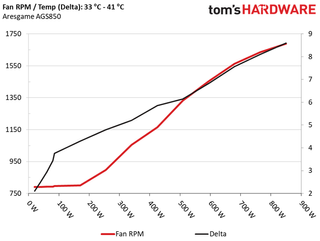
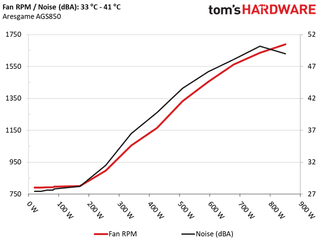
The fan speed profile is aggressive to handle the increased thermal loads.
The following results were obtained at 30 to 32 degrees Celsius (86 to 89.6 degrees Fahrenheit) ambient temperature.
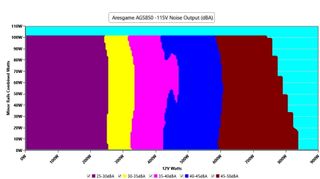
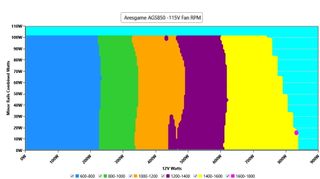
At normal operating temperatures, the PSU's fan speed remains aggressive. With a 250W load, the PSU enters the 30-35 dBA zone, while with more than 600W, it exceeds 45 dBA!
MORE: Best Power Supplies
MORE: How We Test Power Supplies
MORE: All Power Supply Content
Current page: Load Regulation, Hold-Up Time, Inrush & Leakage Current, Efficiency and Noise
Prev Page Specifications and Part Analysis Next Page Protection Features, DC Power Sequencing, Cross-Load Tests and Infrared ImagesAris Mpitziopoulos is a Contributing Editor at Tom's Hardware US, covering PSUs.
-
escksu I think this review simply enforce the fact that you should always buy your PSU from reputable brands like Seasonic, Superflower etc.... For those that you have never heard of, well.....forget it.Reply -
Co BIY Thousands of reviews on Amazon for a product not sold on Amazon. I wonder if any of them are legit ?Reply


